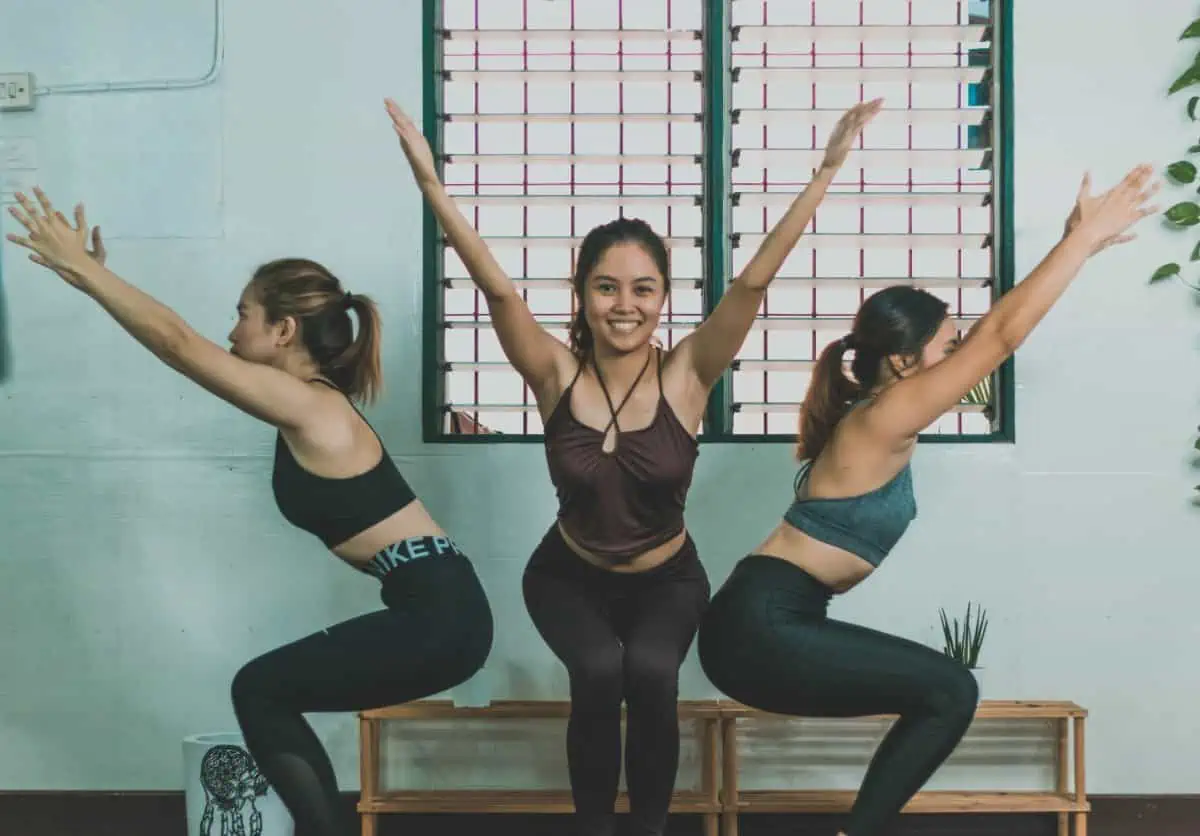Key Takeaway
Chair Pose (Utkatasana) is a full-body strengthening posture that enhances lower body muscles, core stability, and mental focus, suitable for all levels of yoga practitioners.
| CHAIR POSE | |
|---|---|
| Alternate name: | Utkatasana |
| Difficulty level: | Beginner |
| Pose category: | Standing Pose |
| Muscle groups: | Quadriceps (thighs) Glutes (buttocks) Hip flexors Shoulders Upper back muscles Core muscles (abdomen) Ankles |
| Physical benefits: | Strengthens quadriceps, glutes, and core; improves balance and stability. |
| Therapeutic applications: | Back pain, improves posture |
| Preparatory poses: | Mountain Pose (Tadasana) Cobra Pose (Bhujangasana) |
| Counterposes that follow well: | Forward Fold (Uttanasana) Thunderbolt Pose (Vajrasana) Bridge Pose (Setu Bandhasana) |
| Chakras activated: | Root Chakra (Muladhara) |
| Most helpful prop: |  Yoga block between thighs - enhances inner thigh engagement. See latest price |
Taking a seat in a chair is a good way to give yourself a break and rest; that is, unless you’re practicing Utkatasana! This standing yoga posture is a fantastic pose that targets your entire body, from the bottoms of your feet to the top of your head.
You’ll also find that Chair Pose can be a bit of a mental workout as well, as it takes focus and determination to hold this challenging posture.
In English, the name Chair Pose describes the shape of the body as it resembles sitting back into an imaginary chair. In Ashtanga yoga, it is known fully as Awkward Chair Pose.
The traditional Sanskrit name, Utkatasana describes the experience of the pose. Utkat translates to powerful or strong, while asana means pose. So, you may hear a yoga teacher call this posture Powerful Pose, or Fierce Pose.
As a standing yoga posture, Chair Pose is very versatile and easy to use as a transition pose in many yoga flows, including the Sun Salutation B yoga sequence. While definitely challenging, Utkatasana is appropriate even for beginners to practice.
Chair Pose is quite common in many styles of yoga classes, and is a great pose for building heat and strength in the body. Let’s take a closer look at just how beneficial Chair Pose can be!
Contents
Benefits of Chair Pose (Utkatasana)
Taking up a yoga practice is a fantastic way to build physical strength and tone your body. Typically, Chair Pose focuses on working the muscles of the lower body, including the thigh muscles (quadriceps), glutes, and hip flexors.
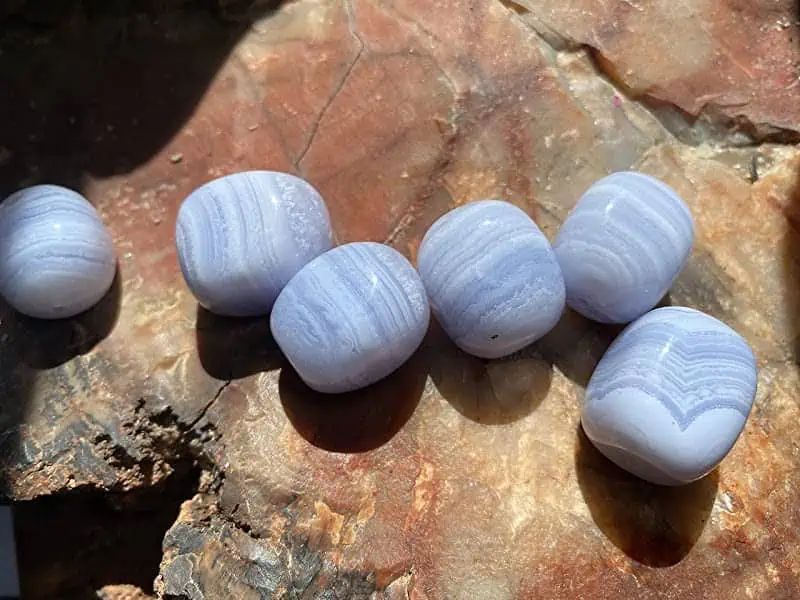
However, many other muscles are put to work in order to bring your body into the Awkward Chair Pose shape! When you extend your arms overhead and lengthen your torso, you tone the shoulders and upper back muscles. You must engage your core muscles to hold your upper body erect, which can help improve posture and relieve back pain over time. Lastly, you build strength and stability in the ankles with Chair Pose as well, which is incredibly important for maintaining mobility as you age.
The physical benefits of Chair Pose (Utkatasana) don’t stop there. This yoga posture is a powerful pose that truly benefits your entire body. It warms your body and increases circulation. With proper alignment, your chest opens and torso lengthens, which improves breathing. Practicing Chair Pose regularly builds endurance and stamina as you rise to the challenge of this physically demanding posture.
To that end, Chair Pose offers many secondary mental benefits. You might notice your legs shaking and becoming fatigued, but by focusing on your breath and holding your Fierce Pose a moment longer, you realize just how strong you are! In this way, Chair Pose can increase your self-confidence, determination, and perseverance.
How to Practice Chair Pose (Utkatasana)
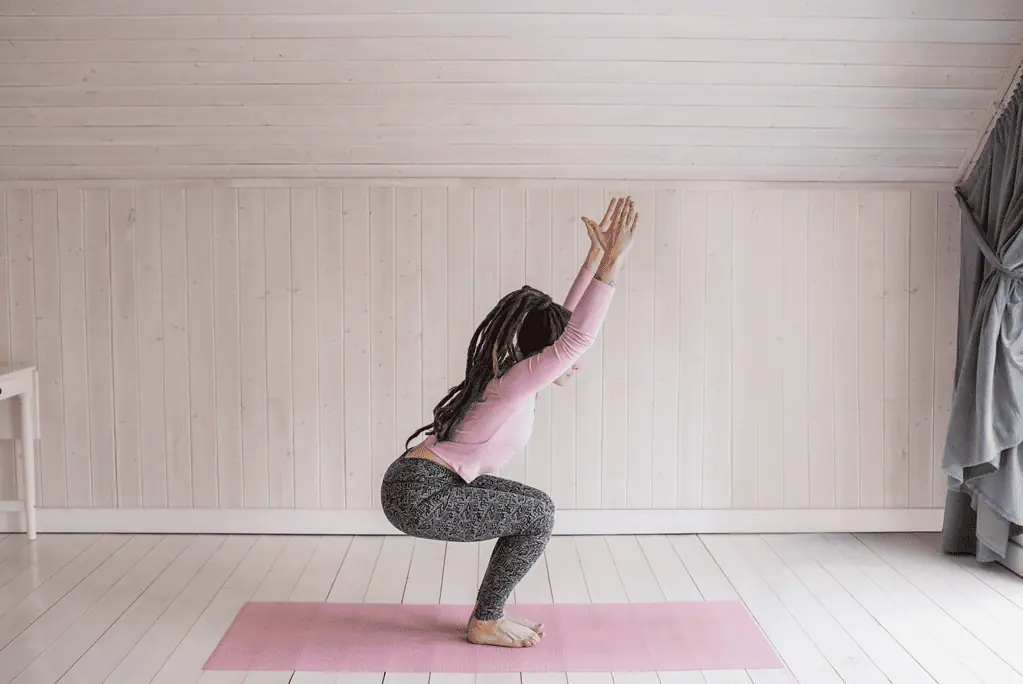
To develop a strong yoga practice, you definitely should try adding Chair Pose to your next yoga sequence! Follow these step-by-step instructions with specific alignment cues, and see just how strong your body is!
- Begin standing in Mountain Pose with your big toes together and your arms at your sides.
- Stand straight and tall as you reach your arms overhead. Rotate your arms so that your palms face each other.
- Keep your spine long as you bend your knees and reach your hips back, as if you are sitting into an imaginary chair behind you.
- Take your weight into your heels and keep bending your knees to approximately a right angle, with your thighs parallel to the floor.
- Lean forward slightly with your torso to counterbalance the weight of your hips reaching behind you. Keep your chest lifted and reach the crown of your head forward and up to maintain length in the spine.
- Spread your shoulder blades down and across your upper back so your upper body stays open.
- Examine the tilt of your pelvis and shine your sitting bones directly towards the floor. Try maintain the natural curve of your lumbar spine.
- Pull your navel in and up and close your rib cage to activate your core muscles. Squeeze your inner thighs together as you feel your legs fire up.
- Hold your Chair Pose for several breaths. Keep your gaze focused as you breathe deeply and steadily.
- To exit chair pose, you can stand up into Mountain Pose, or release down to a Standing Forward Fold.
For a brief visual demonstration of Chair Pose, watch this video:
Contraindications
Chair Pose, while challenging, is a great way to build strength even if you are just beginning a yoga practice. It is generally safe for most people to practice, although there are a few instances when you might want to modify or skip Utkatasana altogether.
If you’ve had a recent shoulder injury or surgery, you can practice Chair Pose with a modified arm position as detailed below.
It is safe to practice Chair Pose during pregnancy. However, later into pregnancy (especially during the third trimester), you will need to keep feet separated at least a hip width distance or even a little wider in Chair Pose, as the belly requires more space.
If you currently are experiencing low blood pressure, headache, discomfort in the hips, or chronic knee pain, it’s best to avoid Chair Pose for the time being.
Chair Pose Modifications
Chair Pose is a workout for the whole body and can feel intense if you are just starting out. When building strength, simple modifications in body position will make this pose accessible no matter your level of yoga experience!
Arm Variations
Traditionally, Chair Pose is practiced with the arms raised, reaching forward and up. In certain cases, especially if you have tight or injured shoulders, this might add a level of difficulty you’re not quite ready for. If you’d like to focus more on your legs and lower body in your Chair Pose, you can try a couple different arm variations.
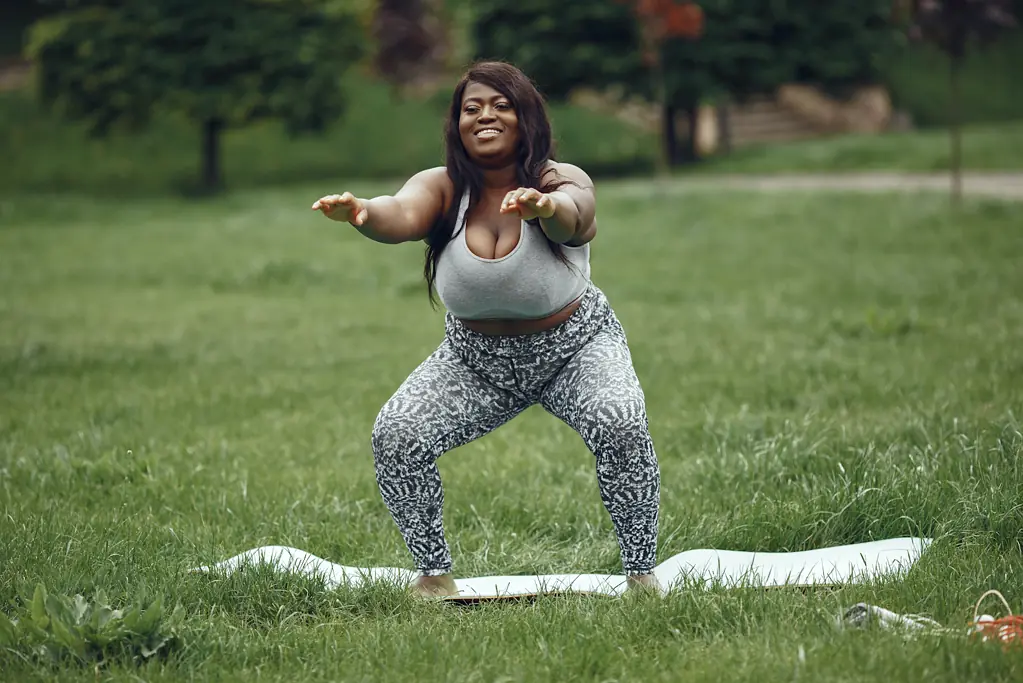
Reach your arms straight out in front of you at about shoulder height, with your palms facing each other. Extend your fingers and spread them wide, keeping all the muscles of your arms active. This will help tone your arms without putting strain on your shoulders.
Another option is to bring your palms together at your heart center in a prayer position. Press your palms together firmly with your elbows pointing out to the sides.
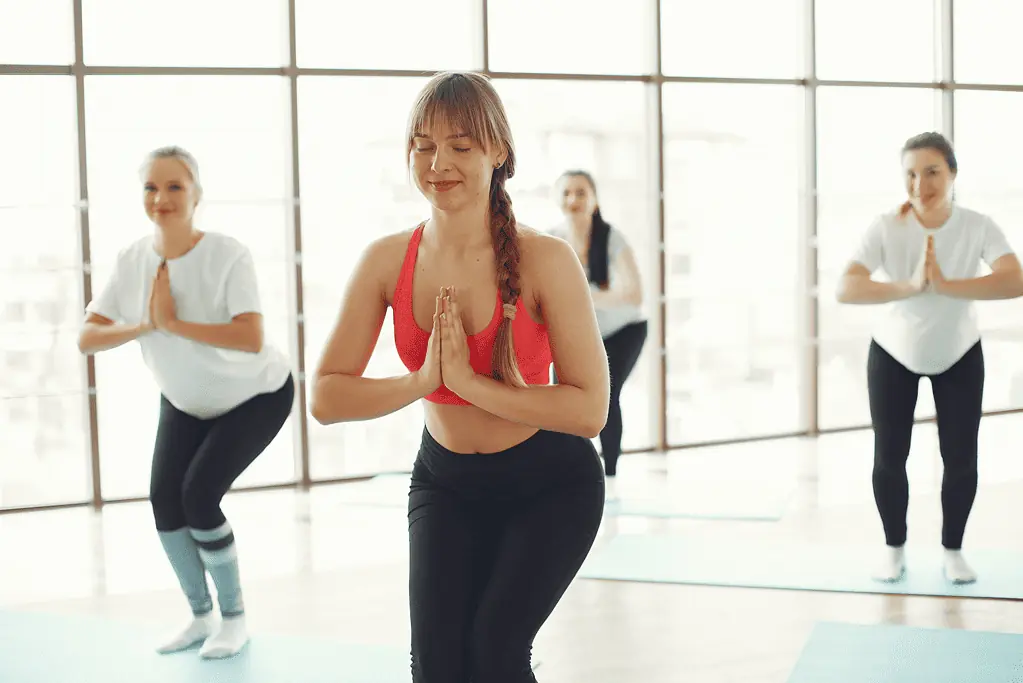
Against A Wall
Chair pose calls for not just strong legs and glutes, but considerable core strength as well. Supporting yourself with a wall is a perfect way to develop strength in your lower body while maintaining optimum posture in your upper body.
Stand a couple feet in front of a wall with your feet placed hip distance apart. Bend your knees and reach your hips behind you, bringing your back against the wall. You can let your hands rest gently on the tops of your thighs or reach your arms straight out in front of you.
Yoga Props
You might use various yoga props to either enhance or diminish the difficulty of Chair Pose.
If your ankles or the muscles of your lower legs are particularly stiff and tight prevent you from placing your feet flat on your mat, place a folded blanket under your heels.
Up for an extra challenge? Place a yoga block between your thighs and squeeze as you bend your knees and sit back into your Chair. This will really engage your inner thigh muscles to tone and strengthen your legs even more!
Variations of Chair Pose (Utkatasana)
Once you feel solid in your Chair Pose, try adding a challenge with these variations. Be sure you have adequate lower body strength and are able to hold regular Chair Pose with proper alignment for several breaths before you take your Utkatasana to the next level.
Revolved Chair Pose
This variation of Chair Pose adds an extra challenge of balance as well as core strength. Plus, twisting poses like Revolved Chair are also great for stimulating your digestive organs.
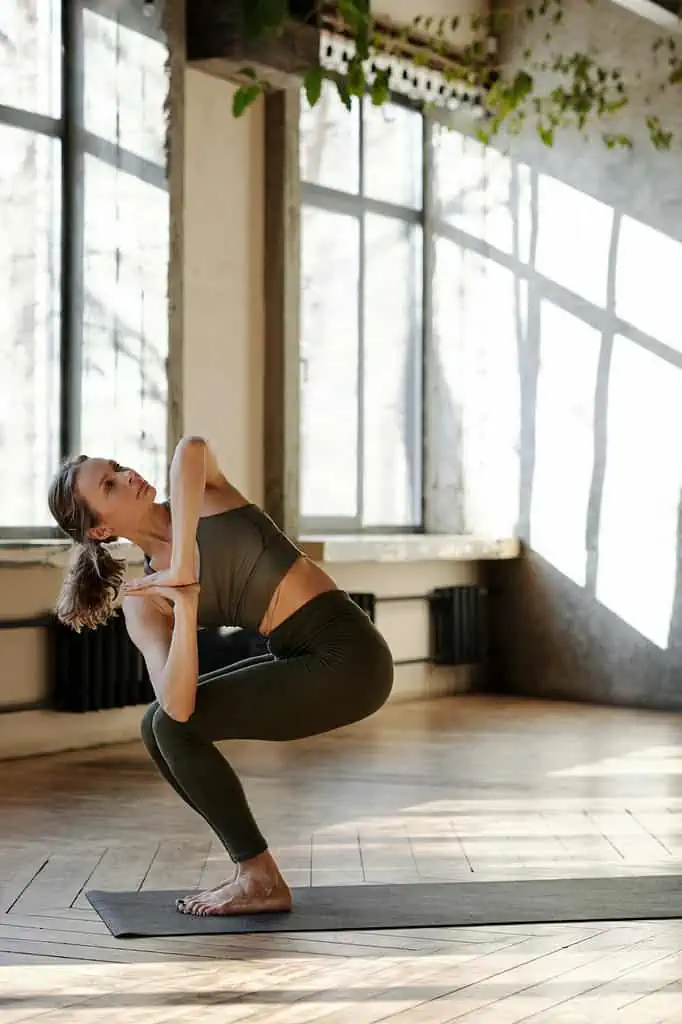
- Begin in Mountain Pose with your big toes touching and heels slightly separated.
- Bend your knees and take your weight back into your heels as you reach your hips back, sitting back into your imaginary chair.
- Lean your torso forward slightly, keeping length in your spine and your chest open. Bring your palms together in a prayer position in front of your chest. Engage your core by pulling your navel in and up.
- Using your abdominal muscles, turn your torso to your right. Bend forward a little more, bringing your left elbow to the outside of your right thigh. With your palms still together in prayer, press firmly and open your chest to your right.
- Keep your knees aligned — check to be sure your left knee has not moved forward. If you notice your left knee has moved a couple inches ahead of your right, square off your hips to adjust your alignment.
- Hold your Revolved Chair Pose for several breaths, then return to your center in regular Chair.
- Repeat Revolved Chair Pose to the other side, turning to the left and placing your right elbow to your left thigh.
One-Legged Chair Pose
Also known as Figure-4 Stretch or Standing Pigeon, this Chair Pose variation stretches your glutes, opens your hips, and strengthens your standing leg.
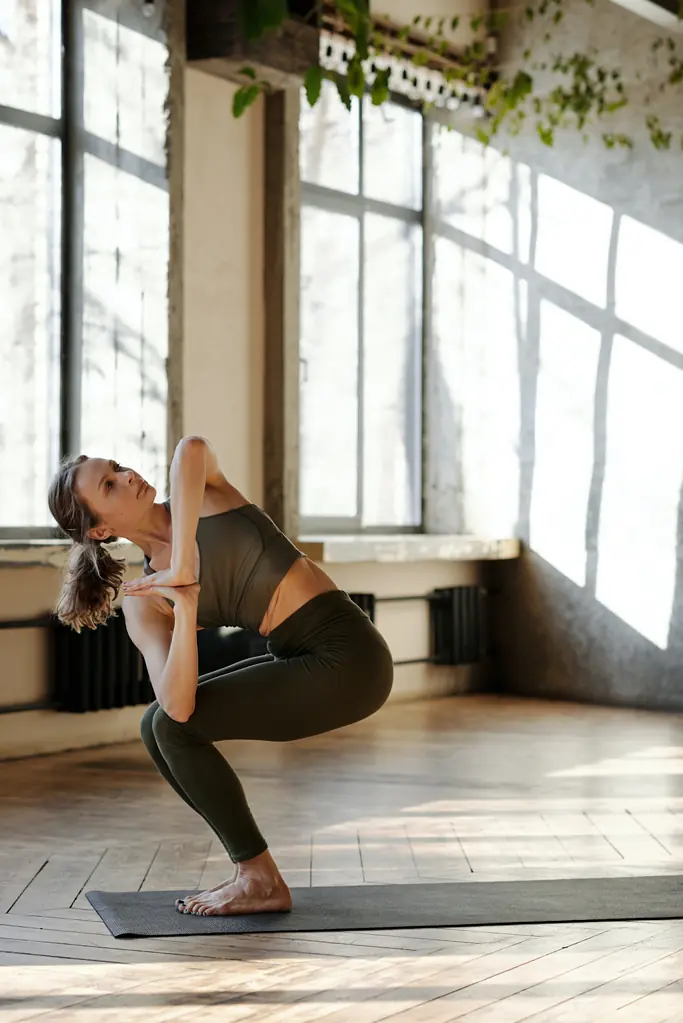
- Bring yourself into traditional chair pose with your knees bent and thighs parallel to the floor. Press your palms together in a prayer position at your heart center.
- Shift your weight slightly into your left foot. Lift your right leg and cross your right ankle over your left thigh. Let your right knee fall open to the side.
- Lift through the inner arch of your left foot to keep your ankle strong and stable. To help with balance, fix your gaze on a spot on the floor several feet in front of you.
- Hold your one-legged chair for five or so breaths, then release your right leg back down to Chair.
- Repeat One-Legged Chair on your other side, shifting your weight into your right foot and crossing your left foot over your right thigh.
Preparatory Poses
Utkatasana is a strong posture that calls for engagement from the whole body as well as the mind. These preparatory poses will help you bring awareness to your alignment especially.
Mountain Pose
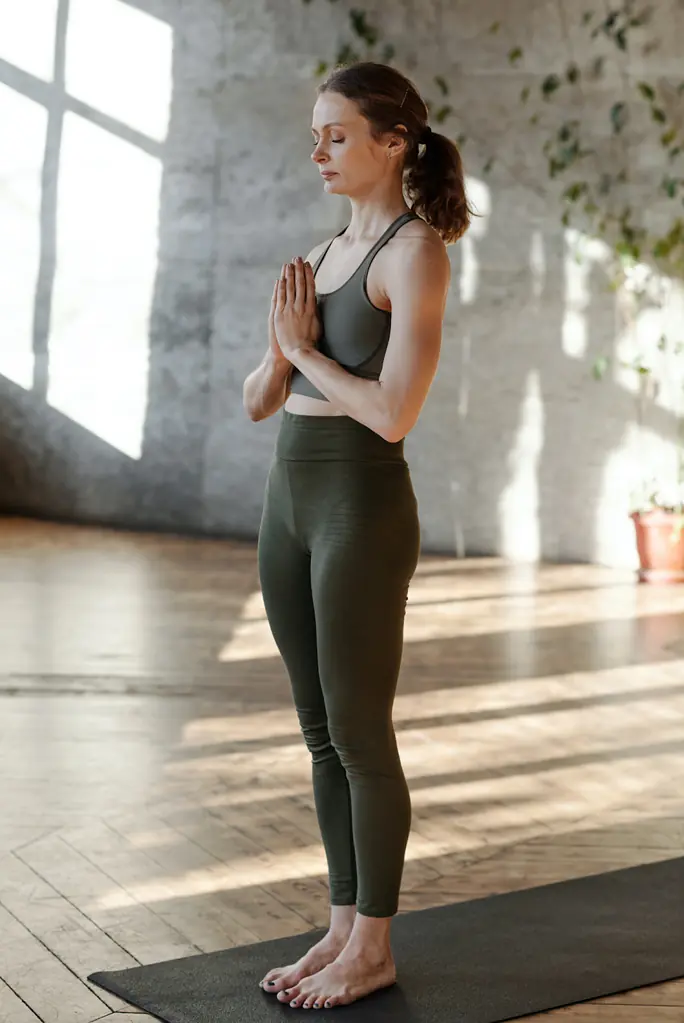
As a foundational yoga pose, Tadasana or Mountain Pose connects you with posture and develops stability for all standing yoga postures.
- Stand tall with your feet together. Bring your arms to your sides with your palms facing forward.
- Reach the crown of your head up towards the sky to lengthen your entire spine. Spread your shoulder blades wide across your upper back, and widen your collar bones so your chest and upper back are open.
- Ground down through the soles of your feet, lifting through your inner arches.
- Close your eyes and tap into your inner strength as you breathe deeply, feeling tall and powerful just like a Mountain.
Cobra Pose
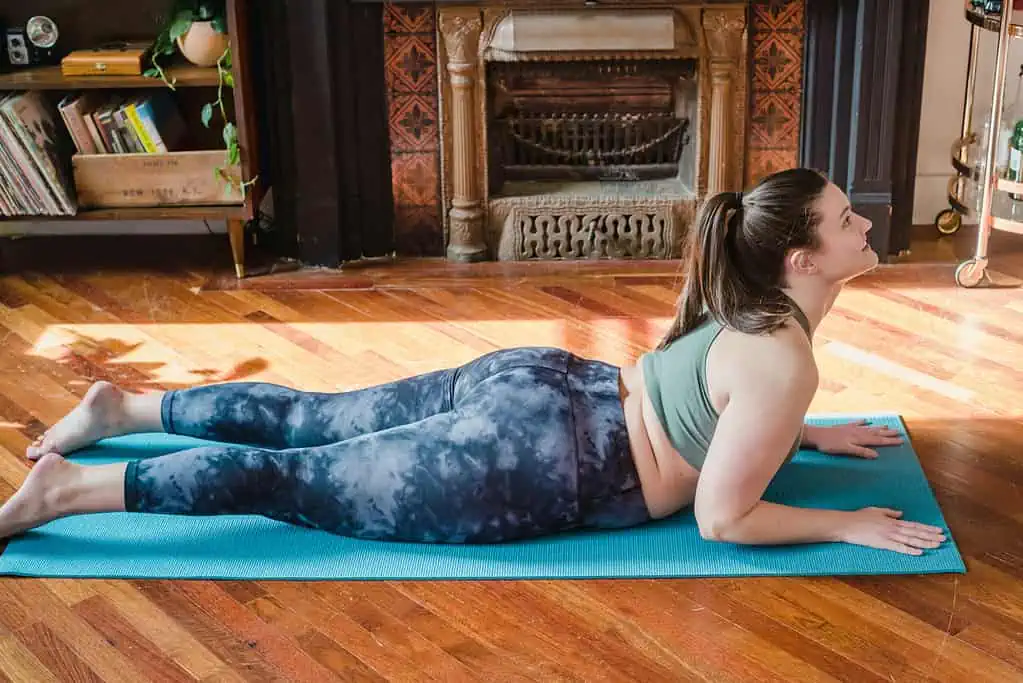
When practicing Utkatasana, the focus is often on strengthening the lower body. However, it is important to pay attention to the shoulders, back, and spine as well. Cobra Pose will open your shoulders and upper back to make sure you maintain length and openness in your upper body.
You can check out our Cobra Pose guide for step-by-step instructions and alignment cues.
Follow-Up Poses
Chair Pose is a quite common and versatile standing yoga posture, so there are many directions you may move to following Utkatasana. Here are some of our suggestions.
Forward Fold
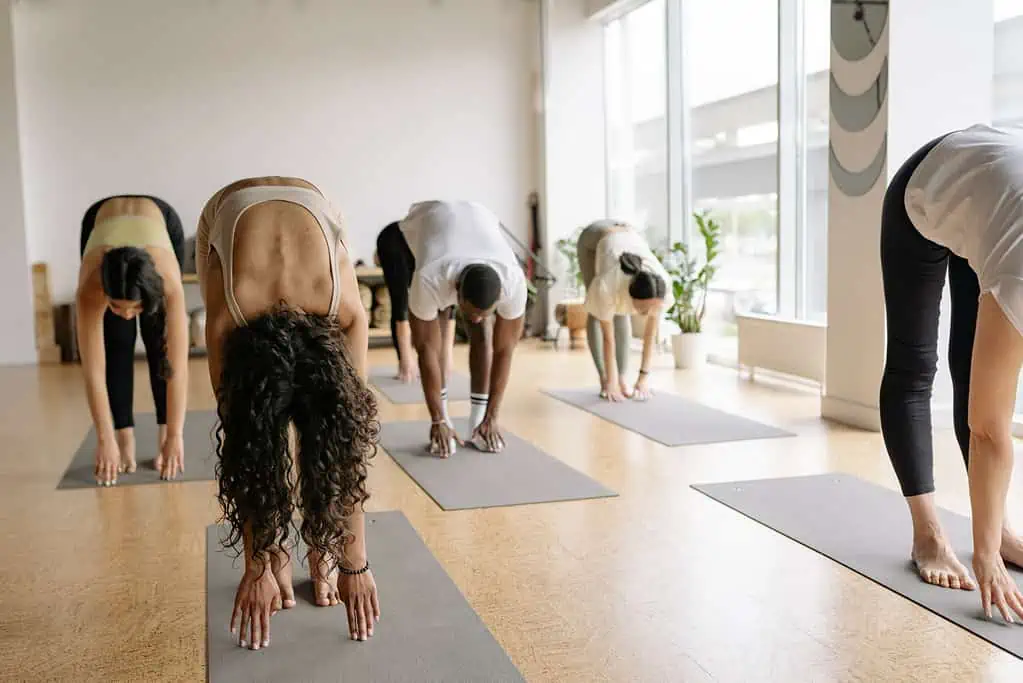
Follow up Chair Pose with a standing Forward Fold to release your shoulders, stretch your back muscles, and give your thigh muscles a rest.
- From chair pose with your arms extended overhead, exhale and bend at your waist, bringing your hands to the floor as you straighten your legs.
- Let the top of your head hang and relax the back of your neck.
- To feel more release in your back, spine, and shoulders, try the Rag Doll variation of Forward Fold: separate your feet to a hip width distance and take hold of your elbows with opposite hands.
Thunderbolt Pose
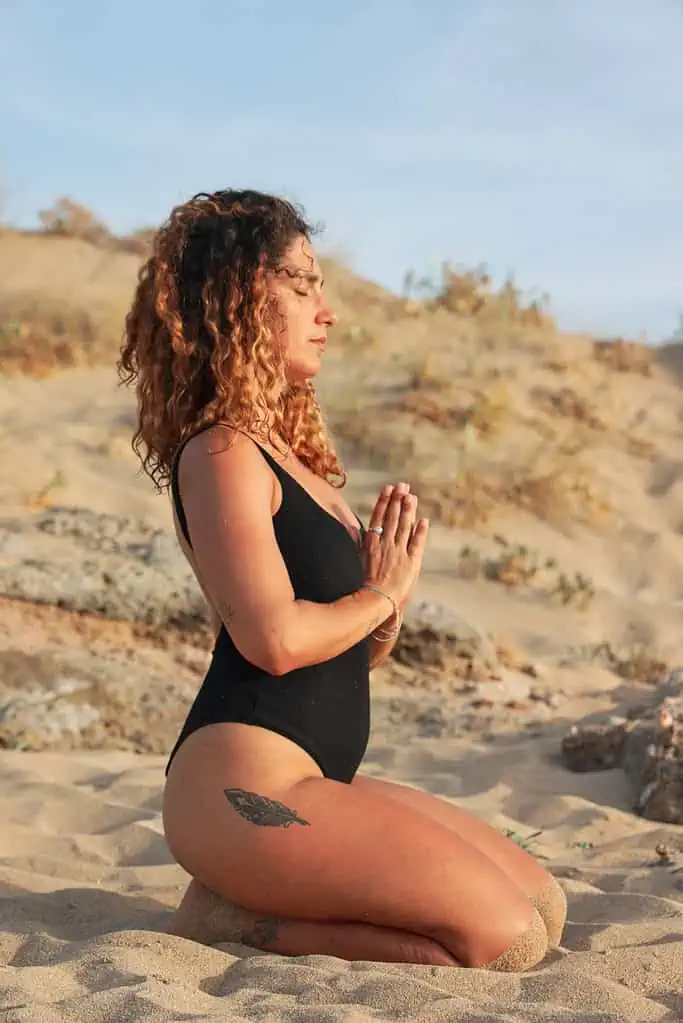
Chair Pose is definitely a workout for your legs, particularly the thighs. Thunderbolt pose will give your quad muscles a gentle stretch after practicing Utkatasana.
- Begin in a kneeling position, with your knees bent and tops of your feet pressing into the floor.
- Sit back on your heels and place your hands on the tops of your thighs.
- Sit tall and reach the crown of your head up towards the sky to lengthen your spine.
- Sit in Thunderbolt Pose for a few breaths, then release by sitting all the way down and swinging your legs out in front of you.
Bridge Pose
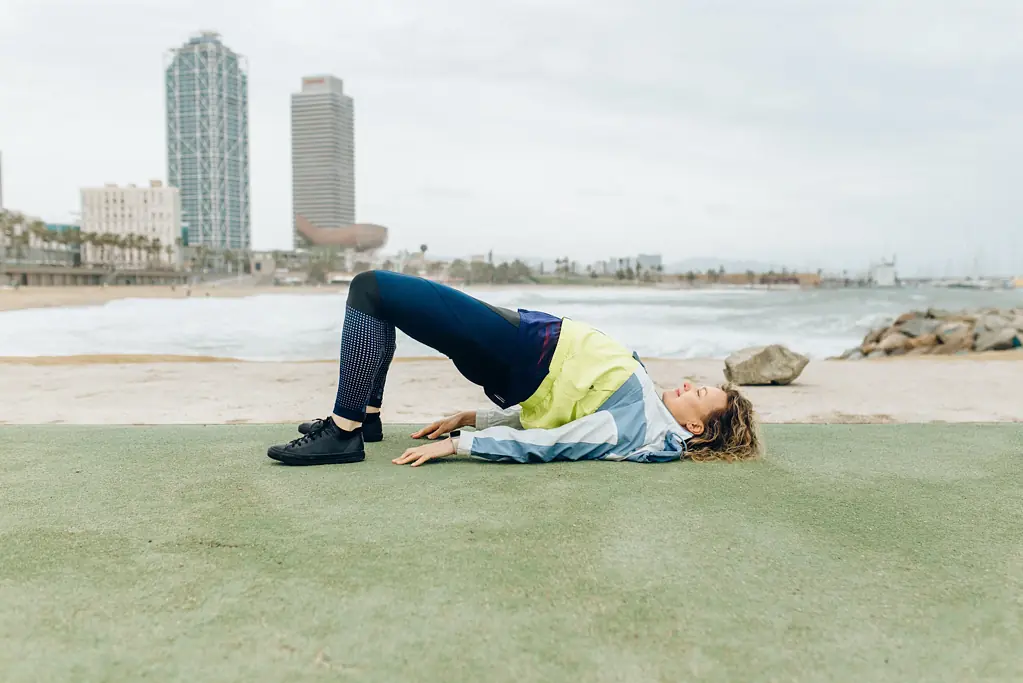
In Chair Pose, the hip flexors are in flexion as you lean your upper body forward slightly. So, Bridge is the perfect counter pose to lengthen your hip flexors after Utkatasana.
For step-by-step instructions and proper alignment, visit our Bridge Pose guide!
Common Questions About Chair Pose
Should my feet be together or separated in Chair Pose?
In certain styles of yoga, Chair Pose is taught with the feet together, big toes touching and heels slightly separated. However, you might find it more comfortable to separate your feet a bit, aligning them under your hips. If you are pregnant or have a bigger belly, you can widen your stance even more. However, no matter the distance between your feet, be sure your toes are facing forward.
How much should I bend my knees in Chair Pose?
Traditionally, the goal in Chair Pose is to bend your knees to approximately a right angle. However, how far you can squat down in Chair Pose depends on your lower body strength as well as range of motion in your upper body. If this is a new yoga posture for you, bend your knees only as much as is comfortable for you to hold the pose for several breaths while keeping your spine elongated and chest lifted.
How long should I hold Chair Pose?
To increase strength in your legs and glutes, try to hold your Chair Pose for 3-5 breaths to begin. As you become stronger, you can hold your Utkatasana even longer. You legs might begin to shake and feel fatigued, but this is a natural result of your muscles working hard!
Should I tuck my tailbone in Chair Pose?
You may have heard a yoga teacher instruct you to slightly tuck your tailbone in Chair Pose. This cue is meant to prevent a sway back position in the lumbar spine, which can cause low back pain. However, tucking the tailbone too much will pull on the muscles of the low back.
Instead, think about pointing your sitting bones straight down to the floor, which will help you maintain the natural curves of your lumbar spine.


